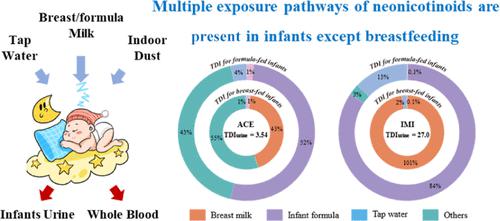当前位置:
X-MOL 学术
›
Environ. Sci. Technol.
›
论文详情
Our official English website, www.x-mol.net, welcomes your
feedback! (Note: you will need to create a separate account there.)
Infantile Internal and External Exposure to Neonicotinoid Insecticides: A Comparison of Levels across Various Sources
Environmental Science & Technology ( IF 10.8 ) Pub Date : 2023-03-22 , DOI: 10.1021/acs.est.2c09538 Henglin Zhang 1 , You Wang 1 , Huimin Zhu 1 , Shaoyou Lu 2 , Yu Wang 3 , Jingchuan Xue 4 , Tao Zhang 1 , Kurunthachalam Kannan 5 , Hongwen Sun 3
Environmental Science & Technology ( IF 10.8 ) Pub Date : 2023-03-22 , DOI: 10.1021/acs.est.2c09538 Henglin Zhang 1 , You Wang 1 , Huimin Zhu 1 , Shaoyou Lu 2 , Yu Wang 3 , Jingchuan Xue 4 , Tao Zhang 1 , Kurunthachalam Kannan 5 , Hongwen Sun 3
Affiliation

|
Little is known about exposure of infants to neonicotinoid insecticides (NEOs). In this study, concentrations of six parent NEOs (p-NEOs) and N-desmethyl-acetamiprid (N-dm-ACE) were measured in urine and whole blood samples from infants, in addition to breast milk, infant formula, and tap water collected in South China. The p-NEO with the highest median concentration in urine (0.25 ng/mL) and blood (1.30) samples was dinotefuran (DIN), while imidacloprid (IMI) was abundant in breast milk (median: 0.27 ng/mL), infant formula (0.22), and tap water (0.028). The older infants (181–360 days) might face higher NEO and N-dm-ACE exposure than younger infants (0–180 days). Blood samples contained a significantly (p < 0.01) higher median concentration of ∑6p-NEOs (2.03 ng/mL) than that of urine samples (0.41), similar to acetamiprid (ACE), IMI, thiacloprid (THD), DIN, and N-dm-ACE, suggesting that NEOs readily partition into blood. Furthermore, breast-fed infants tend to have higher exposure levels than formula-fed infants. Infant formula prepared with tap water augmented the daily intake of ∑NEOs. The external sources contributed 80% of the total dose to IMI and clothianidin (CLO) exposure, while other unknown sources contributed to ACE, THD, and DIN exposure in infants. To the best of our knowledge, this is the first study to assess levels and sources of infantile exposure to NEOs through internal and external exposure assessment.
中文翻译:

婴儿体内和体外接触新烟碱类杀虫剂:各种来源的水平比较
关于婴儿接触新烟碱类杀虫剂 (NEO) 的情况知之甚少。在这项研究中,除母乳、婴儿配方奶粉和自来水外,还测量了婴儿尿液和全血样本中六种母体 NEO ( p -NEO) 和N -去甲基-乙酰氨基嘧啶 ( N -dm-ACE) 的浓度采于华南。尿液 (0.25 ng/mL) 和血液 (1.30) 样品中中值浓度最高的 p-NEO 是呋虫胺 (DIN),而吡虫啉 (IMI) 在母乳(中值:0.27 ng/mL)、婴儿配方奶粉中含量丰富(0.22),和自来水 (0.028)。年龄较大的婴儿(181-360 天)可能比年龄较小的婴儿(0-180 天)面临更高的 NEO 和N -dm-ACE 暴露。血液样本含有显着(p < 0.01) ∑ 6 p -NEOs的中值浓度(2.03 ng/mL) 高于尿样 (0.41),类似于啶虫脒 (ACE)、IMI、噻虫啉 (THD)、DIN 和N -dm-ACE ,这表明 NEO 很容易分配到血液中。此外,母乳喂养的婴儿往往比配方奶喂养的婴儿有更高的暴露水平。用自来水配制的婴儿配方奶增加了 ∑NEO 的每日摄入量。外部来源对 IMI 和噻虫胺 (CLO) 暴露贡献了总剂量的 80%,而其他未知来源对婴儿的 ACE、THD 和 DIN 暴露贡献了。据我们所知,这是第一项通过内部和外部接触评估来评估婴儿接触近地天体的水平和来源的研究。
更新日期:2023-03-22
中文翻译:

婴儿体内和体外接触新烟碱类杀虫剂:各种来源的水平比较
关于婴儿接触新烟碱类杀虫剂 (NEO) 的情况知之甚少。在这项研究中,除母乳、婴儿配方奶粉和自来水外,还测量了婴儿尿液和全血样本中六种母体 NEO ( p -NEO) 和N -去甲基-乙酰氨基嘧啶 ( N -dm-ACE) 的浓度采于华南。尿液 (0.25 ng/mL) 和血液 (1.30) 样品中中值浓度最高的 p-NEO 是呋虫胺 (DIN),而吡虫啉 (IMI) 在母乳(中值:0.27 ng/mL)、婴儿配方奶粉中含量丰富(0.22),和自来水 (0.028)。年龄较大的婴儿(181-360 天)可能比年龄较小的婴儿(0-180 天)面临更高的 NEO 和N -dm-ACE 暴露。血液样本含有显着(p < 0.01) ∑ 6 p -NEOs的中值浓度(2.03 ng/mL) 高于尿样 (0.41),类似于啶虫脒 (ACE)、IMI、噻虫啉 (THD)、DIN 和N -dm-ACE ,这表明 NEO 很容易分配到血液中。此外,母乳喂养的婴儿往往比配方奶喂养的婴儿有更高的暴露水平。用自来水配制的婴儿配方奶增加了 ∑NEO 的每日摄入量。外部来源对 IMI 和噻虫胺 (CLO) 暴露贡献了总剂量的 80%,而其他未知来源对婴儿的 ACE、THD 和 DIN 暴露贡献了。据我们所知,这是第一项通过内部和外部接触评估来评估婴儿接触近地天体的水平和来源的研究。









































 京公网安备 11010802027423号
京公网安备 11010802027423号